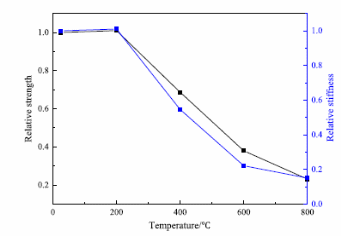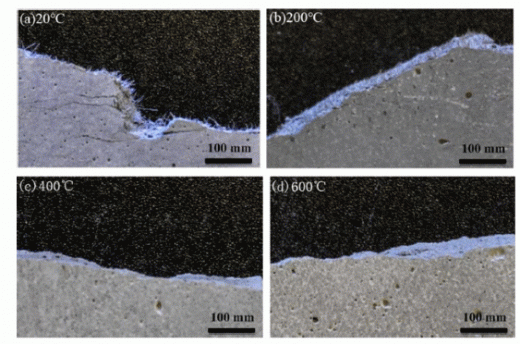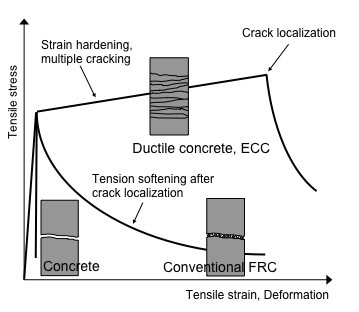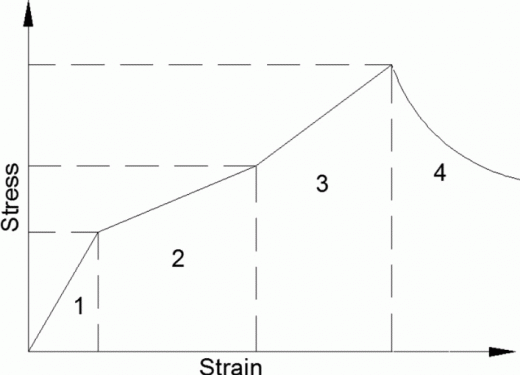Introduction
Engineered Cementitious Composite (ECC) or Strain Hardening Cement-based Composites (SHCC) is a particular type of concrete reinforced with specially selected short random fibers. The strain capacity of such composite is in the range of 3–7%, compared to 0.01% for ordinary Portland cement (OPC). Bendable concrete acts like ductile metal when compared to the brittle nature of OPC cement. As a result of adverse effects on fiber dispersion and overall performance, the coarse aggregates are not used in ECC. Different type of fibers is implemented to impart the tensile strength in ECC. Some fibers include Poly Vinyl Alcohol, Polypropylene fiber, and also natural fibers. ECC shows ductility property in the hardened state, and flexible property in the new state makes ECC applicable to a wide range of construction applications. This report presents a review of ECC durability studies in the literature, with detailed discussions on ECC high-temperature resistance, permeability resistance, and shrinkage resistance. The use of engineered cementitious composites (ECCs) has gained wide attention considering their properties, such as high tensile strength and elasticity values. However, the required methods for direct measurement of tensile strength are not developed adequately.
Need for the Study
It has been observed that conventional concrete causes a lot of pollution. A ton of cement yields half an amount of carbon dioxide into the atmosphere, which is very harmful to the environment. Also, labor charges, equipment charges, all these factors contribute significantly towards the cost of construction, and in this way, a lot of money gets wasted. ECC is a green construction material, consumes 40% less energy, and produces 39% less carbon dioxide than regular concrete, so it is a perfect alternative. Moreover, construction time and effort reduce by 50% to 70%, increasing productivity in the field. Properties of concrete can be manipulated as per convenience, and in this way, there’s a possibility of a single concrete type to complete all the structural elements.
The objective of the study
This report mainly aims to produce sustainable and economical concrete that will revolutionize the construction industry. Speaking elaborately, it aims to-
- To achieve high-durability durability without brittle cracking while maintaining lightweight, high strength, and strain capacity.
- To achieve a more than 3-7 % strain capacity, act more like a malleable metal rather than like brittle glass.
- To eliminate cracking and fracture problems resulting in improved structural durability, safety, and improved performance in infrastructure sustainability.
Statement of Problems
At present, there is no available model to depict the decrease in strain-hardening behavior of ECC throughout its whole service life. Hence, efforts are being made here to-
- To study the scope of such composite in a more advanced form by learning all its properties.
- To know the advantages, it can offer in developing improved performance in buildings.
- To understand its applications that are currently ongoing throughout the world.
Some Literary pieces of evidence
H. Liu, Q. Zhang, G.u. Chongshi, S.u. Huaizhi, V. Li, in their paper, “Influence of microcrack self-healing behavior on the permeability of ECC,” had conducted some studies and showed how fly ash could affect the mechanical properties and also the self-healing behavior of ECC. Compressive and uni-axial tests were conducted to find the influence of fly ash on mechanical properties. The self-healing behavior of ECC with different types of fly ash was evaluated using a permeability test. A scanning electron microscope is used to check the microtopography of self-healing products in a crack. Energy-dispersive X-ray spectroscopy was used for observing chemical characteristics.
Manish A. Kewalramani, Osama A. Mohamed, Zubair Imam Syed (2016), in their paper “Engineered cementitious composites for modern civil engineering structures in hot arid coastal climatic conditions,” observed the effect of ECC in hot arid coastal climatic conditions. Freeze and thaw tests were used to simulate temperature changes. Capillary suction and chloride penetration methods were used to check durability in both cracked and un-cracked ECC samples.
S.H. Said, H.A. Razak investigated the effect of synthetic polyethylene fiber on the strain hardening behavior of ECC in their paper, “The effect of synthetic polyethylene fiber on the strain hardening behavior of engineered cementitious composite (ECC).” They studied the effects of polyethylene fiber on the toughness, compressive and flexural strength of ECC cubes and slabs. Reinforcing index (RI) was taken as the main parameter. As the RI value increased, the compressive strength of the concrete decreased. The ECC material is extremely damage-tolerant and remains ductile even in severe shear loading.
J. Li, Y.X. Zhang, in their paper, “Evolution and calibration of a numerical model for modeling of hybrid-fiber ECC panels under the high-velocity impact,” studied the evolution and calibration of a numerical model for modeling of hybrid fiber ECC panels under high-velocity impact. LS-DYNA commercial software was adopted in this study. Results obtained in the numerical model were validated with the experimental results. A finite element model was developed to simulate the impact behavior of hybrid fiber ECC panels, and the modeling process was validated against experimental results.
K.V. Wishwesh, K.B. Anand, in their paper, “PVA fibre-fly ash cementitious composite: assessment of mechanical properties,” performed experiments in ECC with PVA fibers. Results show that fibers added with the mix help to hold the matrix together, which eliminates the brittle nature of the mix. Their experiments showed 1% PVA fiber and 20% fly ash replacement of cement blocks shows better mechanical properties.
Materials involved
Some of the materials involved in producing such composites are –
1.Fiber reinforcement – These may be in the form of thin fibers of ductile materials like steel or glass that can add strength to the composite to be used in structures. Here coarse aggregate use is eliminated. Instead of that, fibers are used in the fiber-reinforced concrete, such as silica fibers, glass fibers, steel fibers, asbestos fibers, polyvinyl alcohol fibers, etc.
2.Fine sand – Fly ash, silica fume, blast furnace slag can also be used in the concrete. If fine sand is not present, then instead, normal sand can be used, but the strength of the composite will get affected.
3.Slick coating (anti-friction coating)– The slick coating (anti-frictional coating) is provided so that the fibers can pass over one another, increasing the workability of the mix and does not have friction, which may result in cracks in concrete.
4.Superplasticizer– Polycarboxylate ether, lignosulfonates, lignin, naphthalene, etc., is used in the concrete to increase the concrete’s workability.
Properties of ECC
Some of the properties of ECC are –
- High-Temperature Resistance – Under high temperatures, the mechanical properties of ordinary concrete devalue with spalling damage. It has been reported that when the temperature rises to 200 – 350 0C, the fragments will start peeling off from the concrete, and explosive spalling may occur as the temperature continues to increase. This spalling failure of concrete under elevated temperatures is attributed to the accumulated internal tensile stress. Based on this mechanism, ECC has been reported to have advanced performance under high temperatures due to its elasticity maintained by inner randomly distributed fibers. Spalling of ECC can be suppressed, resulting in improved durability under a high-temperature environment. It was found that the incorporation of PVA fibers eliminated the explosive spalling behavior of ECC. With the increase of fly ash content, the high-temperature resistance of ECC was further enhanced. When subjected to high temperature, the strain-hardening capacity of ECC decreases or disappears, resulting in a decrease in its elasticity, premature failure, or excessive deformation. The change in strain-hardening power of ECC after the high temperature was directly caused by the difference in the number of microcracks. A mild temperature (50–100 0C) can effectively enhance the fiber–matrix interface properties and the weakening of yarn and fiber-matrix interface after high temperature (?200 0C), leading to the fibers’ presence as distributed composite defects. At 100 0C, the strain capacity of PVA-ECC improved with the increase of strain rate, while ECC lost ductility and showed strain rate effect at 150 0C. The steel fiber could improve ECC integrity under high temperatures, i.e., the number of debris generated by PVA-ECC at 600 0C is four times that of steel fiber ECC. High temperature also has a significant effect on the compressive strength and stiffness of ECC. Under 200 0C, compressive strength and stiffness of ECC almost maintained constant. However, when the temperature was further extended from 200 0C to 800 0C, compressive strength and stiffness showed a linear declination and dropped by more than 75%.
- Permeability Resistance – Permeability resistance of concrete is closely related to internal pore connectivity, crack depth and crack width. When the crack width is less than 100 ?m, the crack has little effect on concrete permeability. It was found that the maximum crack width of reinforced concrete was proportional to the square root of protective cover thickness.
Permeability resistance of ECC can be further improved due to its self-healing ability. Speed of self-healing is inversely proportional to ECC crack width. It has been reported that the permeability of ECC can be stabilized in 3–4 days with crack width less than 60 ?m. When the crack width was more significant than 100 ?m, it took 7–10 days or even longer to stabilize ECC permeability. ECC with tight cracks can complete self-healing within a short time, effectively preventing attacks from water and corrosive ions.
- Shrinkage Resistance – Excessive shrinkage of ECC causes its long-term durability problems. Many factors affect the drying shrinkage of ECC, including water binder ratio, sand-binder ratio, cement content, fiber volume, and admixture. It was found that ECC shrinkage increased with the increase of water-binder ratio and decreased with the rise of sand-binder balance and fly ash content, while fiber volume content had no significant effect on ECC shrinkage strain. With the increase of sand-binder ratio and water-binder ratio, the total shrinkage rate of ECC is reduced, and the autogenous shrinkage and drying shrinkage tend to be equal.

Fig 1: Effect of temperature on strength and stiffness of ECC
Courtesy: Construction and Building Materials, Elsevier
Further, it was explored that the mechanical properties of PVA-ECC under sub-elevated temperatures (20 0C, 50 0C, 100 0C, and 200 0C). ECC matrix toughness was increased in micro-scale, and PVA fiber strength was degraded under 200 0C exposure, resulting in a decrease in ECC tensile properties. However, due to the reduction of fiber–matrix interface bonding, the adverse effect of tensile properties was weakened.

Fig 2: Microscopic images of tensile fracture surfaces of ECC under different temperatures
Courtesy: Construction and Building Materials, Elsevier
Fig 2 shows microscopic images of the tensile fracture surface of PVA-ECC specimens. It can be seen that with the increase of temperature, the length and number of fibers at the fracture surface gradually decreased, indicating a significant reduction in fiber bridging capacity at a crack. For specimens under 400 0C and 600 0C, the fibers were decomposed entirely, which was also why the strain-hardening behavior of ECC disappeared at high temperatures. At present, there are very few studies on the high-temperature performance of PE-ECC. It is evident that PE-ECC achieves the highest tensile strain capacity at 50 0C, and when the temperature rises to 200 0C, it has almost no tensile strain capacity (equivalent to plain concrete). Strain hardening and multi cracking behavior of PVAECC were maintained up to 2000C, after which ECC became brittle due to melting and decomposition of PVA fibers under elevated temperatures.
Working Mechanism of ECC
Whenever the load increases beyond its limiting value, the solid molecular bond formed between PVA fibers and concrete during hydration prevents it from cracking.

Fig 3: Working mechanism of ECC
Courtesy: Researchgate.net
ECC exhibits tensile strain hardening with multiple microcracking during the inelastic deformation, unlike the conventional fibers reinforced composite. ECC has high ductile properties and due to this property, it is also known as Ductile Fibers Reinforced Composite (DFRCC). The uniaxial tensile behavior of FRC exhibits the quasi-brittle failure that is, after the first tensile crack, tension softening will occur, followed by a continuously widening gap. Many of the modern high-performance fibers reinforced cementitious composite also fall under this category. The conventional FRC exhibits the pseudo strain hardening behavior with significant fiber volume content (8–15%). ECC exhibits the pseudo strain hardening behavior under tensile loading with low fiber volume.

Fig 4: Typical stress-strain behavior of ECC
Courtesy: Materials Today: Proceedings, Elsevier
Typical stress-strain curves of ECC are presented in Fig. above. In Region 1, the composite is deforming linearly elastic, and no crack occurs through the thickness. In region 2, multiple cracking is developing, and the strain increases with further damages and constant crack width. In region 3, multiple cracking is finished, and additional straining results in direct loading of fibers. In region 4, pull-out or rupture of fibers occurs. From that, it is clear that pseudo strain hardening is based on crack mechanics. The short crack limit is associated with the first crack strength, which is crack size-dependent. In contrast, the extended crack limit is achieved the higher pseudo strain hardening, the interface bond between fibers and matrix has to be designed for high absorbed energy.
Conclusion
Without a doubt, transportation officials face an increasing crisis when dealing with the rising cost of maintaining a comprehensive infrastructure system coupled with ever-shrinking funds. One solution is the use of new materials and design technologies that look to increase performance, improve durability, and increase the service life of infrastructure systems. One such example is introducing ECC link slabs to replace mechanical expansion joints between adjacent simple bridge spans. With the unique mechanical characteristic of strain hardening under uniaxial tension up to 4% strain capacity while forming small, closely spaced microcracks, ECC material meets all requirements essential for the link slab application. The necessity of allowing for the deformation of adjacent bridge spans under thermal loads and creating an uninterrupted deck to protect the underlying superstructure and substructure is met.
According to the study, ECC technology focuses mainly on increasing the tensile strength of concrete and does not significantly raise the compressive strength of the material. The reason for the decreased value of PVA fibers is that an oil coating with an amount of 1.2% of fiber weight is applied in PVA to avoid rupturing of yarn when the load acts. Hand mixing cannot be recommended in ECC, which may result in lower compressive strength.
The durability of ECC determines its long-term performance in a virtual environment. This paper reviews up-to-date research progress of ECC durability, including high-temperature resistance, permeability resistance, frost resistance, shrinkage resistance, salt corrosion resistance, etc. The tensile ductility, microcracking behavior, and self-healing ability of ECC benefit its durability. Freeze-thaw conditions and salt environment will not lead to continuous crack extension and matrix peeling of ECC. However, the strain-hardening behavior of ECC was found to decrease due to environmental effects. At present, there is no available model to describe the degradation in strain-hardening behavior of ECC throughout its whole service life. It is highly recommended that more studies to be conducted to solve the research questions raised in the Outlook section, which can be significant to promote ECC engineering applications when durability is of great concern.
References
- V.C. Li, From Micromechanics to Structural Engineering-The design of Cementitious Composites for Civil Engineering Applications, Structural Engineering and Earthquake engineering, Japan Society of Civil Engineers, (2002).
- Cementitious composite bendable concrete, Construction Innovation Forum. 6494 Latcha Road, Walbridge, USA, (2007).
- V.C.Li, G.Fischer, Y.Kim, M.Lepech,S.Qian, M.Weimann, S.Wang, Durable Link Slabs for Jointless Bridge Decks Based on Strain-Hardening Cementitious Composites, CEE Department, University of Michigan, (2003).
- Hongqiang Maa, Cheng Yi, Chao Wub, Review and outlook on the durability of engineered cementitious composite (ECC), Construction and Building Materials, Elsevier (2021).
- S.B. Singh, Pankaj Munjal, Engineered cementitious composite and its applications, Materials Today: Proceedings, Elsevier (2020).
- Behzad Tahmouresi, Parisa Nemati, Mohammad Ali Asadi, Ashkan Saradar, Mohammad Mohtasham Moein, Mechanical strength and microstructure engineered cementitious composites: A new configuration for direct tensile strength, experimental and numerical analysis, Construction and Building Materials, Elsevier (2021).
- Mareena George, Dhanya Sathyan a, K.M. Mini, Investigations on effect of different fibers on the properties of engineered cementitious composites, Materials Today: Proceedings, Elsevier, (2021).
If you have a query, you can ask a question here.


